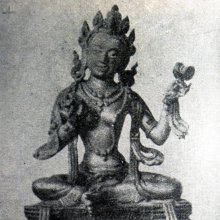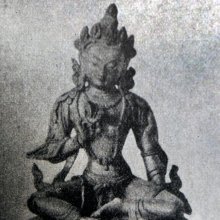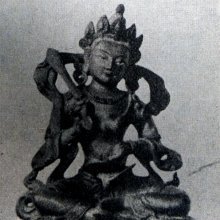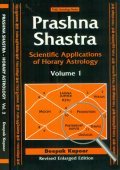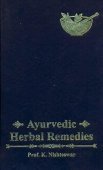Mesha, Mesa, Meṣa, Meṣā, Mesā: 34 definitions
Introduction:
Mesha means something in Buddhism, Pali, Hinduism, Sanskrit, Marathi, Jainism, Prakrit, Hindi, biology. If you want to know the exact meaning, history, etymology or English translation of this term then check out the descriptions on this page. Add your comment or reference to a book if you want to contribute to this summary article.
The Sanskrit terms Meṣa and Meṣā can be transliterated into English as Mesa or Mesha, using the IAST transliteration scheme (?).
Alternative spellings of this word include Mesh.
Images (photo gallery)
In Hinduism
Purana and Itihasa (epic history)
Source: Google Books: Cultural History from the Vāyu PurānaMeṣa (मेष) falls under the category of domesticated animals (grāmya-paśu) according to the Vāyu Purāṇa.
Source: archive.org: Puranic Encyclopedia1) Meṣa (मेष).—A synonym for Indra. Once Indra taking the shape of a goat went and drank the Soma of the sage Medhātithi. Then that sage called Indra 'goat' (meṣa) and that name of Meṣa stuck to him. (Sūkta 51, Anuvāka 10, Maṇḍala 11, Ṛgveda).
2) Meṣa (मेष).—A soldier of Subrahmaṇya. (Śloka 64, Chapter 45, Śalya Parva).
Source: Cologne Digital Sanskrit Dictionaries: The Purana Index1a) Meṣa (मेष).—Sheep born of Sugrīvī;1 Indra took the guise of, to disturb the tapas of Vajrānga's wife.2
1b) Sūrya in, the month of Citra.*
- * Vāyu-purāṇa 105. 46.
Meṣa (मेष) is a name mentioned in the Mahābhārata (cf. IX.44.59) and represents one of the many proper names used for people and places. Note: The Mahābhārata (mentioning Meṣa) is a Sanskrit epic poem consisting of 100,000 ślokas (metrical verses) and is over 2000 years old.

The Purana (पुराण, purāṇas) refers to Sanskrit literature preserving ancient India’s vast cultural history, including historical legends, religious ceremonies, various arts and sciences. The eighteen mahapuranas total over 400,000 shlokas (metrical couplets) and date to at least several centuries BCE.
Natyashastra (theatrics and dramaturgy)
Source: Wisdom Library: Nāṭya-śāstraMeṣa (मेष) is the Sanskrit name of one of Bharata’s sons, mentioned in the Nāṭyaśāstra 1.26-33. After Brahmā created the Nāṭyaveda (nāṭyaśāstra), he ordered Bharata to teach the science to his (one hundred) sons. Bharata thus learned the Nāṭyaveda from Brahmā, and then made his sons study and learn its proper application. After their study, Bharata assigned his sons (eg., Meṣa) various roles suitable to them.

Natyashastra (नाट्यशास्त्र, nāṭyaśāstra) refers to both the ancient Indian tradition (shastra) of performing arts, (natya—theatrics, drama, dance, music), as well as the name of a Sanskrit work dealing with these subjects. It also teaches the rules for composing Dramatic plays (nataka), construction and performance of Theater, and Poetic works (kavya).
Vastushastra (architecture)
Source: Wisdom Library: Vāstu-śāstraMeṣa (मेष) corresponds with the Aries zodiac sign and refers to the first of twelve rāśi (zodiacal sign), according to the Mānasāra. Rāśi is one of the three alternative principles, besides the six āyādiṣaḍvarga, used to constitute the “horoscope” of an architectural or iconographic object. Their application is intended to “verify” the measurements of the architectural and iconographic object against the dictates of astrology that lay out the conditions of auspiciousness.
The particular rāśi (e.g., meṣa) of all architectural and iconographic objects (settlement, building, image) must be calculated and ascertained. This process is based on the principle of the remainder. An arithmetical formula to be used in each case is stipulated, which engages one of the basic dimensions of the object (breadth, length, or perimeter/circumference). All twelve rāśis, except the eighth (vṛścika) are auspicious.

Vastushastra (वास्तुशास्त्र, vāstuśāstra) refers to the ancient Indian science (shastra) of architecture (vastu), dealing with topics such architecture, sculpture, town-building, fort building and various other constructions. Vastu also deals with the philosophy of the architectural relation with the cosmic universe.
Jyotisha (astronomy and astrology)
Source: Wisdom Library: Brihat Samhita by VarahamihiraMeṣa (मेष) refers to the “fixed hindu zodiac” (i.e., the sign of Aries), according to the Bṛhatsaṃhitā (chapter 5), an encyclopedic Sanskrit work written by Varāhamihira mainly focusing on the science of ancient Indian astronomy astronomy (Jyotiṣa).—Accordingly, “If the sun and moon should begin to be eclipsed when only half risen, deceitful men will suffer as well as sacrificial rites. [...] If the sun and moon should be eclipsed when in the sign of Aries (Meṣa), the Pāñcālas, the Kaliṅgas, the Sūrasenas, the people of Kāmboja, of Odra, of Kirāta, soldiers and persons who live by fire will be afflicted with miseries. If the sun or moon should be eclipsed when in the sign of Taurus (Vṛṣabha), shepherds, cows, their owners and eminent men will suffer miseries”.
Source: Wikibooks (hi): Sanskrit Technical TermsMeṣa (मेष).—Sign Aries. Note: Meṣa is a Sanskrit technical term used in ancient Indian sciences such as Astronomy, Mathematics and Geometry.

Jyotisha (ज्योतिष, jyotiṣa or jyotish) refers to ‘astronomy’ or “Vedic astrology” and represents the fifth of the six Vedangas (additional sciences to be studied along with the Vedas). Jyotisha concerns itself with the study and prediction of the movements of celestial bodies, in order to calculate the auspicious time for rituals and ceremonies.
Vaishnavism (Vaishava dharma)
Source: Pure Bhakti: Arcana-dipika - 3rd EditionMeṣa (मेष) corresponds to “aries” (mid April to mid May) and refers to one of the zodiac signs (rāśī) in the Vedic calendar.—Rāśī refers to the different signs of the zodiac through which the sun travels. For precise dates, please refer to a Vedic calendar. In accordance with the zodiac sign the sun is situated in, one would utter [for example, meṣa-rāśī sthite bhāskare]

Vaishnava (वैष्णव, vaiṣṇava) or vaishnavism (vaiṣṇavism) represents a tradition of Hinduism worshipping Vishnu as the supreme Lord. Similar to the Shaktism and Shaivism traditions, Vaishnavism also developed as an individual movement, famous for its exposition of the dashavatara (‘ten avatars of Vishnu’).
Dharmashastra (religious law)
Source: Prācyā: Animals and animal products as reflected in Smṛti textsMeṣa (मेष) refers to a type of goat breed (Hemitragus hylocrius).—The Smṛtis mention several domestic as well as wild animals that are enumerated in context of specifying expiation for killing them, the flesh being used as a dietary article to give satisfaction to the Manes (Pitṛs) in Śrāddha rites, the law of transmigration due to various sins committed as well as in the context of specifying gifts to be given on various occasions. These animals [viz., Meṣa] are chiefly mentioned in the Manusmṛti, Parāśarasmṛti [Chap.6], Gautamasmṛti [17.2 and 15.1], Śātātapasmṛti [II.45-54], Uśānasmṛti [IX.7-9; IX.12-13], Yājñavalkyasmṛti [I.170-171; I.175; I.258- 260], Viṣṇusmṛti [51.3;51.6;51.26;51.33;80.3-14], Uttarāṅgirasasmṛti [X.15-17], Prajāpatismṛti [Śrāddhatyājyavastuvarṇanam. 138-143], 9 Kāśyapasmṛti [Section on Prāyaścittavarṇanam], Vṛddha Hārītasmṛti [6.253-255] and Kātyāyanasmṛti [27.11].

Dharmashastra (धर्मशास्त्र, dharmaśāstra) contains the instructions (shastra) regarding religious conduct of livelihood (dharma), ceremonies, jurisprudence (study of law) and more. It is categorized as smriti, an important and authoritative selection of books dealing with the Hindu lifestyle.
Ayurveda (science of life)
Veterinary Medicine (The study and treatment of Animals)
Source: Shodhganga: Portrayal of Animal Kingdom (Tiryaks) in Epics An Analytical studyMeṣa (मेष) refers to the Nilgiri tahr (Hemitragus hylocrius), according to scientific texts such as the Mṛgapakṣiśāstra (Mriga-pakshi-shastra) or “the ancient Indian science of animals and birds” by Hamsadeva, containing the varieties and descriptions of the animals and birds seen in the Sanskrit Epics such as the Ramayana and Mahabharata.
Toxicology (Study and Treatment of poison)
Source: Shodhganga: Kasyapa Samhita—Text on Visha ChikitsaMeṣa (मेष) refers to “goats”, according to the Kāśyapa Saṃhitā: an ancient Sanskrit text from the Pāñcarātra tradition dealing with both Tantra and Viṣacikitsā—an important topic from Āyurveda which deals with the study of Toxicology (Viṣavidyā or Sarpavidyā).—Gulikā refers to “herbal pills” and represents one of the modes of treatment for the venom (viṣa) of snakes (i.e., viṣacikitsā). Pills are also prepared from a combination of mud, asafoetida, garlic, pepper and coriander seeds. The bile of peacock, goat (meṣa), mongoose, cat, and boars [pittāni meṣanakulaviḍālaśikhipotriṇām] mixed with honey administered in the form of pills also are formidable antidotes

Āyurveda (आयुर्वेद, ayurveda) is a branch of Indian science dealing with medicine, herbalism, taxology, anatomy, surgery, alchemy and related topics. Traditional practice of Āyurveda in ancient India dates back to at least the first millenium BC. Literature is commonly written in Sanskrit using various poetic metres.
Shaktism (Shakta philosophy)
Source: Google Books: Manthanabhairavatantram1) Meṣa (मेष) is the name of the Yuganātha (lord of the ages) of the dvāparayuga (Cf: Meṣanātha), which is associated with Pūrṇagiri, one of the sacred seats (pīṭha), according to the Ṣaṭsāhasrasaṃhitā, an expansion of the Kubjikāmatatantra: the earliest popular and most authoritative Tantra of the Kubjikā cult.—On the basis of hardly more than a hint in the Ṣaṭsāhasrasaṃhitā, it outlines a scheme of sixteen parts for each seat, conscious, no doubt, that this is an ideal number. The commentary normally limits itself to do no more than explain what is presented in the text. This is one of the few instances it adds substantially to its contents [i.e., the Lords of the Ages—Meṣa]. Presumably this is because when it was written the presentation of the features of the seats on this model was the accepted norm.
2) Meṣa (मेष) also refers to one of the disciples of Piṅgala, who is associated with Pūrṇagiri, one of the sacred seats (pīṭha), according to the Manthānabhairavatantra, a vast sprawling work that belongs to a corpus of Tantric texts concerned with the worship of the goddess Kubjikā.

Shakta (शाक्त, śākta) or Shaktism (śāktism) represents a tradition of Hinduism where the Goddess (Devi) is revered and worshipped. Shakta literature includes a range of scriptures, including various Agamas and Tantras, although its roots may be traced back to the Vedas.
Shaivism (Shaiva philosophy)
Source: Google Books: Manthanabhairavatantram (shaivism)Meṣa (मेष) or Meṣanātha refers to the one who is ever intent on realisation, according to the Mahānayaprakāśa by Arṇasiṃha (Cf. verse 182-197).—Accordingly, “He who, by virtue of the innate expansion (of his own consciousness) and freedom, assumes the nature of the senses, without (this thereby) diminishing the glorious power of the Inexplicable (Fourth State of consciousness) in the sphere the objects of sense and who, abandoning (all) exertion (for what is conventionally considered to be) right or wrong, moves (freely) at all times, is known as Meṣanātha who, endowed with the expansion (of consciousness), is ever intent (on realisation)”.
Source: SOAS University of London: Protective Rites in the Netra TantraMeṣa (मेष) refers to “one who sits upon a ram” and is used to describe Viṣṇu, according to the Netratantra of Kṣemarāja: a Śaiva text from the 9th century in which Śiva (Bhairava) teaches Pārvatī topics such as metaphysics, cosmology, and soteriology.—Accordingly, [verse 13.1-9, while describing the appearance and worship of Viṣṇu]—“Or, [the Mantrin] worships a very handsome, eight-armed, yellow Deva. He is naked, sits on a ram (meṣa-upari-sthita), and is unadorned He rests on one horn [of a sheep and] offer up a pile of wheel spokes, the hand... having the shape of a boy. [He is] constantly at play with a flock of beautiful, naked women. [...]”.

Shaiva (शैव, śaiva) or Shaivism (śaivism) represents a tradition of Hinduism worshiping Shiva as the supreme being. Closely related to Shaktism, Shaiva literature includes a range of scriptures, including Tantras, while the root of this tradition may be traced back to the ancient Vedas.
Kama-shastra (the science of Love-making)
Source: Shodhganga: Elements of Art and Architecture in the Trtiyakhanda of the Visnudharmottarapurana (kama)Meṣa (मेष) refers to a “ram”.—Cf. Meṣakukkuṭalāvakayuddhavidhi which refers to the “art of cock fighting, ram fighting and quail fighting”, representing one of the “sixty four kinds of Art”, according to the Kāmasūtra of Vātsyāyaṇa.—Indian tradition, basically includes sixty four Art forms are acknowledged. The references of sixty four kinds of kalā are found in the Bhāgavatapurāṇa, Śaiva-Tantras, Kāmasūtra of Vātsyāyaṇa etc.
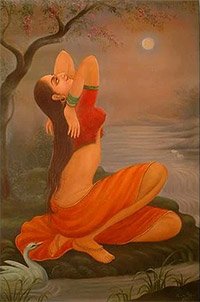
Kamashastra (कामशास्त्र, kāmaśāstra) deals with ancient Indian science of love-making, passion, emotions and other related topics dealing with the pleasures of the senses.
General definition (in Hinduism)
Source: archive.org: Vedic index of Names and SubjectsMeṣa (मेष) denotes ‘ram’ in the Rigveda and later, while Meṣī means ‘ sheep’. Both words are also used to denote the ‘wool’ of the sheep, especially as employed for the Soma filter. A wild (āraṇya) ram is mentioned in the Vājasaneyi-saṃhitā.
In Buddhism
Tibetan Buddhism (Vajrayana or tantric Buddhism)
Source: Wisdom Library: Tibetan BuddhismMeṣa (मेष) is the name of a Rāśi (zodiac sign) mentioned as attending the teachings in the 6th century Mañjuśrīmūlakalpa: one of the largest Kriyā Tantras devoted to Mañjuśrī (the Bodhisattva of wisdom) representing an encyclopedia of knowledge primarily concerned with ritualistic elements in Buddhism. The teachings in this text originate from Mañjuśrī and were taught to and by Buddha Śākyamuni in the presence of a large audience (including Meṣa).

Tibetan Buddhism includes schools such as Nyingma, Kadampa, Kagyu and Gelug. Their primary canon of literature is divided in two broad categories: The Kangyur, which consists of Buddha’s words, and the Tengyur, which includes commentaries from various sources. Esotericism and tantra techniques (vajrayāna) are collected indepently.
Biology (plants and animals)
Source: Google Books: CRC World Dictionary (Regional names)Mesa in India is the name of a plant defined with Trichodesma indicum in various botanical sources. This page contains potential references in Ayurveda, modern medicine, and other folk traditions or local practices It has the synonym Borago indica L. (among others).
Example references for further research on medicinal uses or toxicity (see latin names for full list):
· Cyclopaedia.
· Prodromus Florae Novae Hollandiae (1810)
· Species Plantarum (1753)
· Plantae e Familiae Asperifoliarum Nuciferae (1818)
· Prodr. (DC.) (1846)
· Trichodesma (1817)
If you are looking for specific details regarding Mesa, for example extract dosage, side effects, diet and recipes, pregnancy safety, chemical composition, health benefits, have a look at these references.

This sections includes definitions from the five kingdoms of living things: Animals, Plants, Fungi, Protists and Monera. It will include both the official binomial nomenclature (scientific names usually in Latin) as well as regional spellings and variants.
Languages of India and abroad
Pali-English dictionary
Source: BuddhaSasana: Concise Pali-English Dictionarymesa : (m.) a ram.

Pali is the language of the Tipiṭaka, which is the sacred canon of Theravāda Buddhism and contains much of the Buddha’s speech. Closeley related to Sanskrit, both languages are used interchangeably between religions.
Marathi-English dictionary
Source: DDSA: The Molesworth Marathi and English Dictionarymēśā (मेशा) [or मेशी, mēśī].—a (mēṣa) Sheep-faced, mealy-mouthed, imbecile, mean and sneaking.
--- OR ---
mēṣa (मेष).—m (S) A ram. 2 The sign Aries.
Source: DDSA: The Aryabhusan school dictionary, Marathi-Englishmēśā (मेशा) [-śī, -शी].—a Sheep-faced.
--- OR ---
mēṣa (मेष).—m A ram. The sign Aries. mēṣī f An ewe.
Marathi is an Indo-European language having over 70 million native speakers people in (predominantly) Maharashtra India. Marathi, like many other Indo-Aryan languages, evolved from early forms of Prakrit, which itself is a subset of Sanskrit, one of the most ancient languages of the world.
Sanskrit dictionary
Source: DDSA: The practical Sanskrit-English dictionaryMeṣa (मेष).—
1) A ram, sheep.
2) The sign Aries of the zodiac.
Derivable forms: meṣaḥ (मेषः).
--- OR ---
Meṣā (मेषा).—Small cardamoms.
Source: Cologne Digital Sanskrit Dictionaries: Shabda-Sagara Sanskrit-English DictionaryMeṣa (मेष).—m.
(-ṣaḥ) 1. A ram. 2. The sign Aries. 3. A kind of drug. f.
(-ṣā) A sort of small cardamom, brought from Guzerat. f. (-ṣī) An ewe. E. miṣ to contend with, aff. ac .
Source: Cologne Digital Sanskrit Dictionaries: Benfey Sanskrit-English DictionaryMeṣa (मेष).— (vb. mih, probably for mekṣa), I. m. 1. A ram. [Pañcatantra] iii. [distich] 40. 2. The sign Aries. Ii. f. ṣī, An ewe.
Source: Cologne Digital Sanskrit Dictionaries: Cappeller Sanskrit-English DictionaryMeṣa (मेष).—[masculine] ram, sheep, in Veda also a fleece or anything woollen; [feminine] ī ewe.
Source: Cologne Digital Sanskrit Dictionaries: Monier-Williams Sanskrit-English Dictionary1) Meṣa (मेष):—m. (√2. miṣ) a ram, sheep (in the older language applied also to a fleece or anything woollen), [Ṛg-veda] etc. etc.
2) the sign of the zodiac Aries or the first arc of 30 degrees in a circle, [Sūryasiddhānta; Varāha-mihira; Bhāgavata-purāṇa]
3) a species of plant, [Suśruta]
4) Name of a [particular] demon, [cf. Lexicographers, esp. such as amarasiṃha, halāyudha, hemacandra, etc.] (cf. nejam)
5) Meṣā (मेषा):—[from meṣa] f. small cardamoms, [cf. Lexicographers, esp. such as amarasiṃha, halāyudha, hemacandra, etc.]
Source: Cologne Digital Sanskrit Dictionaries: Yates Sanskrit-English DictionaryMeṣa (मेष):—(ṣaḥ) 1. m. A ram; Aries; a drug. f. (ṣā) Cardamoms. (ṣī) Ewe.
Source: DDSA: Paia-sadda-mahannavo; a comprehensive Prakrit Hindi dictionary (S)Meṣa (मेष) in the Sanskrit language is related to the Prakrit words: Aṇimisa, Aṇimesa, Mesa.
[Sanskrit to German]
Sanskrit, also spelled संस्कृतम् (saṃskṛtam), is an ancient language of India commonly seen as the grandmother of the Indo-European language family (even English!). Closely allied with Prakrit and Pali, Sanskrit is more exhaustive in both grammar and terms and has the most extensive collection of literature in the world, greatly surpassing its sister-languages Greek and Latin.
Hindi dictionary
Source: DDSA: A practical Hindi-English dictionary1) Meṣa (मेष) [Also spelled mesh]:—(nm) Aries—the first sign of the zodiac; a ram; —[saṃkrāṃti] the day when the sun crosses into the mansion of Aries.
2) Mesa (मेस) [Also spelled ves]:—(nm) a mess.
...
Prakrit-English dictionary
Source: DDSA: Paia-sadda-mahannavo; a comprehensive Prakrit Hindi dictionaryMesa (मेस) in the Prakrit language is related to the Sanskrit word: Meṣa.
Prakrit is an ancient language closely associated with both Pali and Sanskrit. Jain literature is often composed in this language or sub-dialects, such as the Agamas and their commentaries which are written in Ardhamagadhi and Maharashtri Prakrit. The earliest extant texts can be dated to as early as the 4th century BCE although core portions might be older.
Kannada-English dictionary
Source: Alar: Kannada-English corpusMēṣa (ಮೇಷ):—
1) [noun] a male sheep; a ram.
2) [noun] (myth.) name of a hell.
3) [noun] (astron.) a northern constellation between Pisces and Taurus; the Aries.
4) [noun] (astrol.) the first sign of the zodiac; Aries.
5) [noun] the plant Nardostachys jatamansi of Valerianaceae family; spikenard.
--- OR ---
Mēsa (ಮೇಸ):—[noun] = ಮೇಷ [mesha].
Kannada is a Dravidian language (as opposed to the Indo-European language family) mainly spoken in the southwestern region of India.
See also (Relevant definitions)
Starts with (+46): Mesacirunki, Mesha-sankranti, Meshacankiramanam, Meshacankiranti, Meshacarman, Meshadimahardasha, Meshahrit, Meshahvaya, Meshaja, Meshaka, Meshakambala, Meshakiritakayana, Meshakshi, Meshakshikusuma, Meshakukkutalavakayuddhavidhi, Meshakusuma, Meshalocana, Meshalochana, Meshalu, Meshamamsa.
Ends with (+38): Akshinimesha, Amesha, Animesha, Atmesha, Bhavonmesha, Bhimesha, Cirannimesha, Darahamesha, Dharmesha, Dhvantonmesha, Gautamesha, Ghushmesha, Gomesha, Gramesha, Hamesha, Harahamesha, Janmesha, Kalamesha, Kamesha, Kshmesha.
Full-text (+127): Meshanda, Meshakshikusuma, Meshavishanika, Meshalocana, Meshashringa, Meshi, Meshalu, Meshavalli, Meshashringi, Meshahrit, Meshapushpa, Meshakusuma, Meshayutha, Meshamamsa, Meshakambala, Meshahvaya, Nimesha, Meshaka, Vishana, Animisa.
Relevant text
Search found 41 books and stories containing Mesha, Mesa, Meṣa, Mēśā, Meśā, Mēṣa, Meṣā, Mēsa, Mesā; (plurals include: Meshas, Mesas, Meṣas, Mēśās, Meśās, Mēṣas, Meṣās, Mēsas, Mesās). You can also click to the full overview containing English textual excerpts. Below are direct links for the most relevant articles:
Rig Veda (translation and commentary) (by H. H. Wilson)
Cidgaganacandrika (study) (by S. Mahalakshmi)
Verse 160 [Śakti’s abode tranforms Sheep stronger than Elephant] < [Chapter 3 - Third Vimarśa]
Verse 37 [Bindu and Visarga] < [Chapter 2 - Second Vimarśa]
Trishashti Shalaka Purusha Caritra (by Helen M. Johnson)
Part 9: Dispute over meaning of aja < [Chapter II - Rāvaṇa’s expedition of Conquest]
Puranic encyclopaedia (by Vettam Mani)
List of Mahabharata people and places (by Laxman Burdak)
List of Mahabharata tribes (by Laxman Burdak)
Related products
